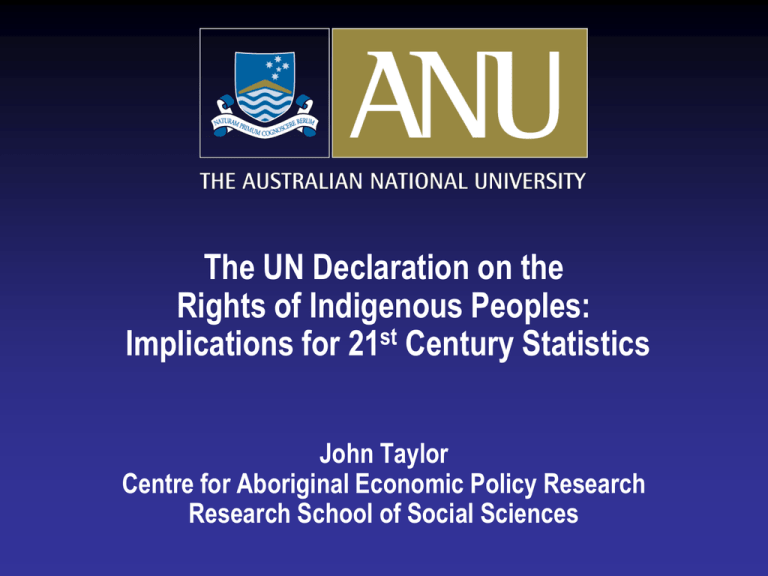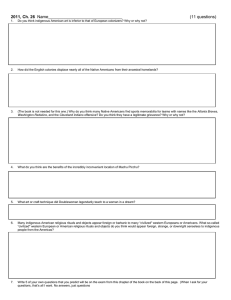Professor John Taylor.ppt
advertisement

The UN Declaration on the Rights of Indigenous Peoples: Implications for 21st Century Statistics John Taylor Centre for Aboriginal Economic Policy Research Research School of Social Sciences Banyjima view of wellbeing “Life is a bit better out here because of mining and those agreements. But my thing is my own kids, we’re not pushing them into what we want them to be. They can go and work in the mine, but they will be men and will have kids of their own, and they need to be there for their own kids to teach them their culture. Because it’s about carrying on the traditional cultural ways teaching knowledge skills, the language, going to ceremony, going out on country. Some of those mining men aren’t there for all that and that’s no good” (Banyjima elder, 2004) UN Declaration Article 42 Article 42 The United Nations, it bodies, including the Permanent Forum on Indigenous Issues, and specialized agencies, including at the country-level, [and States] shall promote respect for and full application of the provisions of this Declaration and follow up the effectiveness of this Declaration. The implementation gap “If the Declaration is going to be effectively utilised in the promotion and protection of the human rights of Indigenous peoples it will need to be clearly understood by States and Indigenous peoples, and these parties will need to design and execute strategies to ensure that Indigenous peoples enjoy the benefit of those rights”. Malezar, 2009 UN Declaration Articles 18, 19 and 23 Article 18 Indigenous peoples have the right to participate in decision-making in matters that would affect their rights, through representatives chosen by themselves in accordance with their own procedures, as well as maintain and develop their own indigenous decision-making institutions. Article 19 States shall consult and cooperate in good faith with the indigenous peoples concerned through their own representative institutions in order to obtain free, prior and informed consent before adopting and implementing legislative or administrative measures that may affect them. Article 23 Indigenous peoples have the right to determine and develop priorities and strategies for exercising their right to development. In particular, indigenous peoples have the right to be actively involved in developing and determining health, housing, and other economic and social programmes affecting them and, as far as possible, to administer such programmes through their own institutions. COAG Views on Engagement & Partnerships ‘Effective engagement with Indigenous communities is critical to ensuring that Indigenous people’s needs and aspirations are built into the planning and implementation of initiatives agreed by COAG’ ‘Working with Aboriginal and Torres Strait Islander people in the development of implementation plans is critical as their input, ideas and solutions will contribute to the overall success and sustainability of the reforms. Their active participation is integral to the effective design and implementation of the measures’ ‘As bilateral and local implementation plans are developed, it will be important to ensure that appropriate structures are established to facilitate local level community engagement and partnerships, collaborative decision making and ownership of implementation’ (COAG National indigenous Reform Agenda 2008: A-31). Fitzroy Valley Cadastral Geography Fitzroy Valley Cultural Geography Rights-based statistics for Indigenous Community Governance • Cultural geography (clans, language groups, incorporated polities) • Decision-making (customised data base/targeting) • Organisational performance (service delivery outcomes) • Strategic direction (needs analysis/projection) • Participation and voice (local enumerators/priority indicators/governing up) • Governance environment (fiscal flows/cost structures) • Governance capacity (statistical training and local skilling) Implications of the UN Declaration on the Rights of Indigenous Peoples • Recognise that it has implications beyond existing collections • Determine who the Indigenous ‘peoples’ are Agreements, Treaties & Negotiated Settlements (ATNS) database National Native Title Tribunal Office of the Registrar of Indigenous Corporations • Establish what they want to measure • Consider how this might be done • Provide advice, support and training as required • Establish an Indigenous Governance Statistical Support Unit? • Whose responsibility? ABS, FAHCSIA…..?








